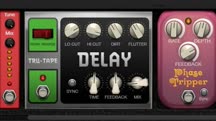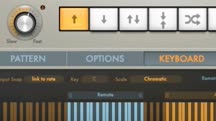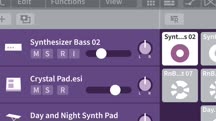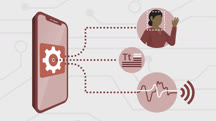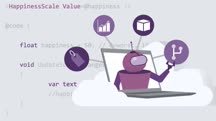Course catalog
Categories
Showing 881-900 of 1,450 items.
Lightroom: Working with Video (53615)
Photographers are being asked to shoot video more and more these days—and Lightroom can help. All the same features you use to organize and develop your still photos can be applied to your motion footage. Plus, explore additional tools for playing, adjusting, and trimming video so you present just the best parts to collaborators and clients. In this course, aimed at photographers somewhat new to the video workflow, Rich Harrington shows how to get your footage into Lightroom, create tonal and color adjustments and custom develop settings, and publish and share your video on platforms like Facebook, Flickr, and Behance. Rich also covers how to build a simple slideshow that mixes photography and videography.
This course was created and produced by RHED Pixel. We're honored to host this training in our library.
This course was created and produced by RHED Pixel. We're honored to host this training in our library.
LinkedIn Creator Mode (215183)
The term “creator economy” describes the work that people and organizations produce—such as videos, photos, or blog posts—to garner a following online. The LinkedIn feed is driven by creators looking for a way to connect with their audience. Are you looking to become a creator, or are you already creating but want to build a larger following? The Creator Profile feature on LinkedIn gives you a set of tools to jumpstart your presence in the creator ecosystem on LinkedIn. Kim Kaupe, a successful LinkedIn creator, introduces you to Creator Mode, how to turn it on and get started using it, and more. Kim explains the “talks about” section and how to add your own hashtags. She covers how to customize your banner, add a short introduction video to your profile, and implement a follower button and a featured section. Plus, Kim goes over how to add the pronunciation feature to your name so other can feel confident when meeting you or introducing you to others.
LinkedIn Learning Highlights: Project Management (209505)
Aspiring and experienced project managers: Discover all that LinkedIn Learning has to offer. Enjoy this selection of curated highlights from our very best project management courses. Explore core skills that are universal to every practice, such as persuasion, collaboration, and adaptability, and then dive into the most popular methodologies, starting with traditional approaches to integration, scheduling, budgeting, and more. Review agile and scrum workflows, and learn if certification is the right choice for your career. Our instructors also touch on popular topics such as innovation and cross-functional team building. Each video is a two- to four-minute consolidation of the top tips and insights from our industry-leading instructors.
LinkedIn Premium Quick Tips (215676)
Find your next job, or simply get ahead in your field, with LinkedIn Premium. In this course, instructor Oliver Schinkten provides quick answers to common "How do I...." questions. Oliver covers features you can use to improve your productivity, ranging from InMail to privacy settings to out-of-office replies. He also offers quick help for using Premium features that benefit job-hunters, such as Job Insights, Top Applicant, Resume Builder, and Interview Prep.
Linux: Files and Permissions (220062)
When it comes to managing Linux servers securely, permissions and access control are crucial. In this course, computer science instructor and Linux enthusiast Grant McWilliams explains how to manage files and directories, create links, and set permissions in Enterprise Linux 8. Grant covers how to maintain access control to files through the standard Linux permission system and access control lists. He also shows how to grant or revoke access to files and directories for users and groups as well as how to set up special bits for privilege escalation, global writable directories, and permission inheritance.
Linux: Network Configuration (218702)
Networking is a fundamental service on a Linux system. Though Linux is widespread, there are many methods of configuring network settings. In this course, instructor Scott Simpson demonstrates how to configure network settings on systems running a variety of Linux distributions. He goes over networking configuration basics like configuration management tools and network interfaces. Scott covers manual network configuration tools, such as ifconfig, the ip command, DHCP, and more. He explains how to configure networks using ifupdown, NetworkManager, Netplan, and systemd-networkd. Plus, Scott dives into hostnames, firewall configuration, and monitoring network port activity.
Linux: Overview and Installation (229956)
Linux is a term that we are hearing more often lately, but what is it? In this course, instructor Grant McWilliams explains what Linux is and how it differs from other operating systems, then walks through how to install it to a virtual machine and use it. Grant tells you about Linux and its history and gives you an overview of the versions—called distributions—of Linux that are available. He goes over virtualization, including how to install VirtualBox and create a virtual machine in VirtualBox. Once you’ve created and optimized your virtual machine, Grant steps through installing and configuring Enterprise Linux, including the GNOME 3 desktop. He concludes with useful advice on how you can install popular software from third-party repositories in Linux and how you can customize your GNOME 3 desktop.
Linux: Shells and Processes (218532)
While the Linux operating system works with a graphical desktop interface much like Windows or macOS, with Linux, most of the system administration is done in the shell. Using the command line in the shell gives you the power to do tasks that would be more difficult using other methods, so having a solid grasp on how to use the shell can help you work faster and be more productive. In this course, Grant McWilliams provides an introduction to the Linux command line. He teaches you how to customize your shell, and shows some powerful shell tricks and shortcuts that can increase your speed and efficiency using the command line. Grant also explains how to create complex administration tools by stacking together simpler commands using named and unnamed pipes and redirects; how to start, pause, and end processes; and how to schedule one-time jobs and recurring jobs, and more.
Linux: Shells and Processes (2017) (225995)
In this course, gain a more thorough understanding of the shell and system processes to help you work faster and more efficiently in Linux. Follow computer science instructor and Linux enthusiast Grant McWilliams as he dives into Linux shells and their environments, and explains how to customize your shell. He discusses using the Bash shell, and covers topics like command and variable substitution. Grant also explains how to stack simpler commands together using named and unnamed pipes and redirects; discusses how to start, pause, and end processes; shows how to schedule one-time jobs and recurring jobs; and covers complex system services.
Listen to Lead (217070)
Listening is a critical skill that empowers leaders to make strong connections and an impact. In this course, Dr. Eric Zackrison explains how to be a leader who makes people feel heard by understanding others more effectively, overcoming barriers to listening, controlling emotions, being present, and becoming an active listener. When you're listening, it's important to truly understand and engage with the other person. Listening helps you reach an agreement faster and become a trusted advisor. Eric teaches how to overcome common barriers to good listening, such as confusion, miscommunication, personal biases, and emotional reactivity. He highlights how to listen directly and avoid common pitfalls to listening well. Eric also discusses how to be present when you're listening to others and how to use nonverbal cues. In conclusion, he presents several useful tips on how to actively listen.
This course was created by Madecraft. We are pleased to host this training in our library.

This course was created by Madecraft. We are pleased to host this training in our library.

Logic Pro X: Effects (227967)
Dive deeply into the wide array of built-in effects in Logic Pro X and learn how to use them to create rich, vibe-y productions. Engineer and music producer Evan Sutton shares some of his favorite stock plugins and effects, showing how to tweak the individual settings to achieve different sounds with different instruments for different genres. Explore the equalization (EQ) plugins and ways to use them to add character and fine-tune your mix. Discover how to use compressors to help control the dynamics of your work, and spatial effects like reverb and delay that help you simulate virtual environments and create stunning effects. Then learn how to use modulation and pitch-based effects like chorus, flanging, phasing, and pitch shifting, as well as multi-fx units that simulate live rigs, racks, and pedalboards. Each lesson helps you get the most versatility and best sound from each Logic Pro effect.
Logic Pro X: MIDI Plug-Ins and Effects (225417)
Are you a music producer or composer, and are you curious about the MIDI tools available in Logic Pro? In this course, instructor Evan Sutton walks you through the various stock MIDI plug-ins and effects included in Logic Pro X and how you can use each in your own productions. Evan begins with classic arpeggiator patterns and alternate uses. He shows you how to use the chord trigger and the transposer functions independently and with the arpeggiator, then goes into adding complexity and rhythmic expressiveness with the note repeater. Evan explains how to make controllers more expressive and how to adjust velocity curves. He discusses how to use the modulator for a whole new level of control and the randomizer for a bit of musical chaos. Evan concludes with some of his favorite Scripter presets and uses.
Logic Pro X: Producing Music with Live Loops (227984)
Learn how to use Live Loops in Logic Pro 10.5 to produce music. Instructor Scott Hirsch starts by introducing basic concepts for working in the Live Loops grid view. Next, Scott shows how to integrate the new Step Sequencer and Drummer Tracks. Find out how to establish a composition by building scenes in the Live Loop grid. Scott also demonstrates the process of recording your Live Loop performance into the traditional timeline. Explore how to use the new Sampler and Quick Sampler. After that, Scott introduces how to use Drum Synth, Step Sequencer, and how to design your own drum machine to create evocative-sounding and sequenced beats. Then, learn about mixing and remixing with Remix FX and Drum Machine designer enhancements.
Logic Pro: Producing Electronic Music (210321)
Electronic music is an umbrella term for a wide variety of genres and sounds, from ambient, dub, acid house, trap, drum and bass, dubstep, and more. But whatever style you produce, Logic Pro can handle it. This powerful DAW is uniquely suited to capturing your creativity and expressing your sonic ideas. In this course, instructor Nate Mars shows you the core techniques professionals use to produce electronic music in Logic Pro.
He starts with building the foundation of the track—the drums. He shows how to program beats in Ultrabeat, utilize your own samples, and create drumbeats for a variety of genres. He then moves into creating basslines for house, trap, dubstep, and other genres, and getting a great deep sub-bass sound. He next moves into creating lead synth sounds, starting with Logic Pro's built-in Alchemy and Retro synths. He also goes into using samples and adding sound effects. Then he pulls it all together and demonstrates ways to arrange the tracks, use creative effects, mix the tracks together, and use automation to finalize the mix. Plus, learn how to send your MIDI note and clock data to external synths from Logic Pro X—a fun way to experiment with analog sounds.
He starts with building the foundation of the track—the drums. He shows how to program beats in Ultrabeat, utilize your own samples, and create drumbeats for a variety of genres. He then moves into creating basslines for house, trap, dubstep, and other genres, and getting a great deep sub-bass sound. He next moves into creating lead synth sounds, starting with Logic Pro's built-in Alchemy and Retro synths. He also goes into using samples and adding sound effects. Then he pulls it all together and demonstrates ways to arrange the tracks, use creative effects, mix the tracks together, and use automation to finalize the mix. Plus, learn how to send your MIDI note and clock data to external synths from Logic Pro X—a fun way to experiment with analog sounds.
Logo Trend Report 2021 (222153)
Have you wondered how to maintain relevance with your logo design in a field that is constantly evolving? In this course, Bill Gardner, president of Gardner Design and founder of LogoLounge.com, shows you new and engaging symbolism and techniques to keep your logo design skills keen and ahead of your peers. Bill walks through 15 trends in-depth and discusses how each designer found a different successful solution using the same general concept. He also covers five additional trends that are just on the verge of introduction and how they may impact you. Additionally, viewers of this course will be given access to an archive of 12 years of trends, to help you understand how design arrived where it is today and determining where it will be tomorrow.
Lumion Essential Training (222340)
Now any architect can create beautiful renders quickly. With Lumion, you work in real time. Production-quality images can be saved to disk in seconds. Lumion can also produce videos and animated sequences from the same project file. In this course, instructor Brian Myers covers the essentials of this powerful visualization tool. Learn how to import CAD models, add cameras, and build out a beautiful environment, with different types of virtual weather and terrain. Brian shows how to add water features and foliage, as well as assign and adjust materials to help your renders look more realistic. Plus, learn how to work with the Build Mode context menu to replace, move, duplicate, and randomize positioning of items—without affecting any of the other objects or settings in your render. Brian closes the course by showing how to render video and still images with the same steps you can use in your own Lumion projects.
Machine Learning for iOS: Core ML and Create ML (227355)
Want to incorporate machine learning into your iOS app? With the Core ML SDK and the Create ML app from Apple, you can quickly start integrating machine learning features into your projects. In this course, Emmanuel Henri covers the basics of machine learning, as well as how to work with Core ML and Create ML to add machine learning models to your apps. Emmanuel covers the different parts of the Core ML SDK, how to set up a new project using Create ML, and how to get input values into and test a model. He also steps through how to integrate your machine learning model into an iOS application and convert models from non-iOS sources.
Machine Learning with Logistic Regression in Excel, R, and Power BI (217903)
Excel, R, and Power BI are applications universally used in data science and across businesses and organizations around the world. If you’ve spent any time trying to figure out how to better model your data to get useful insights from it that you can act upon, you’ve most likely encountered these applications. In this course, Helen Wall shows how to use Excel, R, and Power BI for logistic regression in order to model data to predict the classification labels like detecting fraud or medical trial successes. Helen walks through several examples of logistic regression. She shows how to use Excel to tangibly calculate the regression model, then use R for more intensive calculations and visualizations. She then illustrates how to use Power BI to integrate the capabilities of Excel calculations and R in a scalable, sharable model.
Machine Learning with ML.NET (234393)
Welcome to Machine Learning with ML.NET. In this course, instructor Pranav Rastogi guides you through the concepts of machine learning, what you can build with these concepts, and how to get started. First, Pranav explains what ML.NET is and what you can do with the framework. He covers how to build a ML model for sentiment analysis of customer reviews and explains how to classify incoming GitHub issues into one of the many tags (labels) using a multiclass classification algorithm. Pranav shows you how to recommend movies for users using collaborative filtering-based recommendation approach. He concludes by discussing how deep learning enables many more scenarios, using sound, images, text and other data types.
This course was created by Microsoft.NET. We are pleased to host this training in our library.
This course was created by Microsoft.NET. We are pleased to host this training in our library.
Machine Learning with Python: Foundations (218192)
You’ve probably heard about machine learning before, but have you ever wondered what that term really means? How does a machine learn? Have you thought about building a machine learning model, but didn’t know where to start? In this course, Frederick Nwanganga introduces machine learning in an approachable way and provides step-by-step guidance on how to get started with machine learning via the most in-demand language in use today, Python. Frederick starts with exactly what it means for machines to learn and the different ways they learn, then gets into how to collect, understand, and prepare data for machine learning. He also provides guided examples of how to accomplish each step using Python. Finally, he brings it all together to build, evaluate, and interpret the results of a machine learning model in Python.










